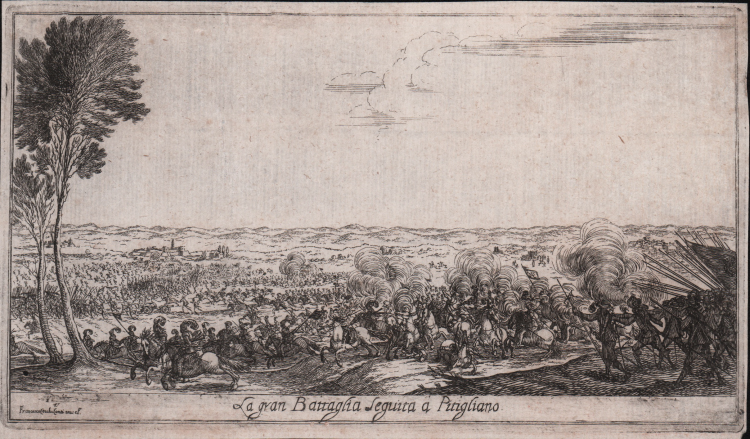




| Reference: | S46768 |
| Author | Francesco CECCHI CONTI |
| Year: | 1643 |
| Zone: | Pitigliano |
| Measures: | 202 x 115 mm |



| Reference: | S46768 |
| Author | Francesco CECCHI CONTI |
| Year: | 1643 |
| Zone: | Pitigliano |
| Measures: | 202 x 115 mm |
Etching, 1643, signed in plate at lower left Francesco Cecchi Conti inv. e F.
Belongs to the very rare series, Vedute e battaglie seguite in Toscana tra gli eserciti guerreggianti l'anno 1643 [Views and battles followed in Tuscany between the warring armies the year 1643].
The frontispiece of the collection is preserved in the collection of the Musei Civici of Monza
The war event is part of the so-called First Castro War (1641-1644), when, after the papal arms had occupied the Duchy of Castro, owned by the Farnese family, in 1641, an alliance between the Grand Duchy of Tuscany, the Republic of Venice and the Duchy of Modena arose. The episode presented is the siege of Pitigliano, organized by the papal army, under the command of Cardinal Antonio Barberini, and in particular the end of it, thanks to the intervention of the troops of the Tuscan League, together with Venice and Modena, under the orders of Don Alonso Strozzi.
Author of the plate is the engraver Francesco Cecchi Conti, of whom few works are known, who was active in Florence around the middle of the 17th century. The influence of Callot and Della Bella is clearly discernible in his style, especially in his skill in the use of perspective techniques.
Magnificent proof, rich in tone, printed on contemporary laid paper, trimmed to the copperplate or with thin margins, in very good condition.
Very rare work.
Francesco CECCHI CONTI (notizie intorno al 1643)
|
active in Florence around the middle of the 17th century. The influence of Callot and Della Bella is clearly discernible in his style, especially in his skill in the use of perspective techniques.
|
Francesco CECCHI CONTI (notizie intorno al 1643)
|
active in Florence around the middle of the 17th century. The influence of Callot and Della Bella is clearly discernible in his style, especially in his skill in the use of perspective techniques.
|